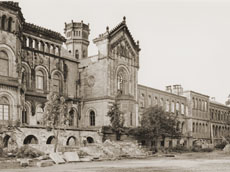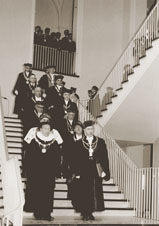
During the Second World War, major parts of the Institute of Technology were destroyed in air raids. More than half of the Welfenschloss lay in ruins. Of the remaining more than 20 separate buildings, only five were complete and the rest destroyed to a greater or smaller extent.
Clearing and rebuilding after the war was possible only with the active participation of the students. Prospective students had to contribute 600 hours and later 1,000 hours of rebuilding work before they could be admitted as students.
The reconstruction of many of the lecture theatres was supported by donations from members of Hannover Hochschulgemeinschaft. Some lecture theatres still bear the names of the patrons who financed their reconstruction. For the anniversary celebrations in 1956 the Lichthof, a covered atrium in the main building, was inaugurated.
During denazification after 1945, eleven full professors at Hannover Institute of Technology were dismissed in 1945 and 1946; five of them were temporarily interned.

In the following years, however, academics who had had a successful career in the Nazi era were also appointed to the Institute of Technology, such as Konrad Meyer. Otto Flachsbart and Günther Schiemann, who had had to leave the Institute of Technology in the Third Reich, were rehabilitated.
Flachsbart received his chair back in 1945. Schiemann became a supernumary professor at Hannover Institute of Technology in 1946, and in 1956 he was appointed Director of the Institute of Chemical Engineering.
The field of activity at Hannover Institute of Technology expanded in 1951 with the creation of a Department of Shipbuilding in the tradition of the former Danzig Institute of Technology, and in 1952 with the integration of the College of Horticulture and Land Culture as the fourth faculty. In 1954 there were ca 2,900 students at the Institute of Technology. Among them were 103 women and 85 international students from 21 different countries.








